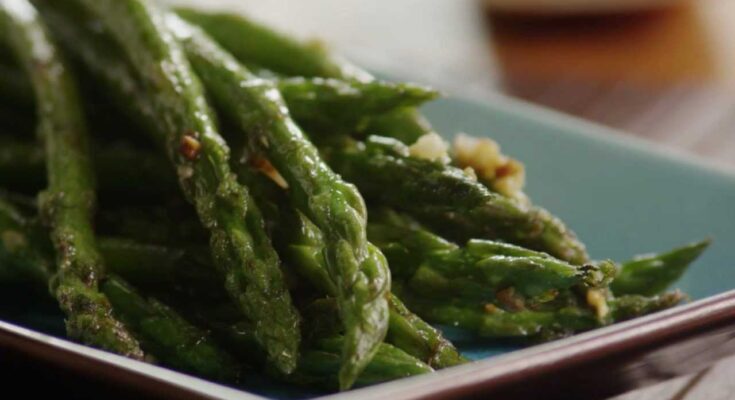Sautéed Asparagus Recipe: Looking for a quick, healthy, and absolutely delicious side dish? Sautéed asparagus checks all the boxes. It’s vibrant, crisp-tender, and so flavorful you’ll want to serve it with every meal.
Whether you’re a beginner cook or a seasoned kitchen pro, this detailed guide will walk you through everything you need to make the perfect sautéed asparagus. Let’s dive in.
Why Sautéed Asparagus is a Must-Try Side Dish
If you’re bored with the same old steamed vegetables or need a fast, flavorful veggie to round out your dinner plate, sautéed asparagus is the solution. This dish is a staple in countless kitchens for a good reason: it’s incredibly easy to prepare and goes with just about anything. Imagine a crisp snap with each bite and a buttery, garlicky aroma wafting through your kitchen — that’s sautéed asparagus done right.
This dish can be made in under 10 minutes and doesn’t require any fancy techniques or ingredients. Just a bit of oil, garlic, salt, and a hot pan, and you’re set. Whether served alongside grilled chicken, pan-seared salmon, or even pasta, sautéed asparagus fits right in.
It’s the ultimate go-to for weeknight dinners, date nights, or when you’re hosting and want a fast yet elegant side dish.
Health Benefits of Asparagus
Not only is sautéed asparagus tasty, but it’s also incredibly nutritious. Asparagus is packed with fiber, folate, and vitamins A, C, and K. It’s also a good source of antioxidants like glutathione, which helps protect your cells from damage. If you’re trying to manage your weight, asparagus is low in calories and high in water content, which means it helps keep you full without weighing you down.
Even better? Asparagus supports digestion thanks to its high inulin content—a prebiotic that helps good gut bacteria thrive. It’s a great veggie for detoxifying your body naturally, and it has diuretic properties that help flush out excess salt and fluid.
So yes, it’s green, it’s crunchy, it’s flavorful, and it’s doing your body a ton of good.
Ingredients You’ll Need
Essential Ingredients for Basic Sautéed Asparagus
To make a simple and delicious sautéed asparagus, you’ll need just a handful of basic ingredients that are likely already in your kitchen:
- Fresh asparagus (1 bunch) – Aim for medium-sized stalks for the best texture and flavor.
- Olive oil (2 tablespoons) – For sautéing; adds richness and helps crisp the edges.
- Salt (½ teaspoon) – Enhances natural flavors.
- Black pepper (¼ teaspoon) – Adds a bit of warmth and contrast.
- Garlic (2-3 cloves, minced) – Adds aromatic flavor and depth.
These ingredients form the core of a classic sautéed asparagus recipe. They’re simple, but when cooked right, they create a flavorful and satisfying side that’s hard to beat.
Optional Add-Ons to Enhance Flavor
Want to jazz up your sautéed asparagus and make it more gourmet or tailored to your preferences? Here are some optional ingredients to consider:
- Butter (1 tablespoon) – Swapped or combined with olive oil for a richer taste.
- Lemon zest or juice (1 teaspoon) – Adds brightness and cuts through the richness.
- Parmesan cheese (2 tablespoons, grated) – A salty, savory finish.
- Red pepper flakes (a pinch) – For a spicy kick.
- Fresh herbs (parsley, thyme, or dill) – Adds a fresh, green touch.
- Balsamic glaze or vinegar (a drizzle) – Sweet and tangy complexity.
Adding these can take your basic sautéed asparagus to restaurant-quality levels. Mix and match based on what’s in your pantry or what pairs best with your main dish.
Kitchen Tools Required
Basic Cooking Equipment
You don’t need a full professional kitchen to pull off sautéed asparagus—just a few essentials:
- Large skillet or sauté pan – Nonstick or stainless steel works best for even cooking.
- Tongs or a spatula – Helps turn the asparagus without bruising it.
- Cutting board and sharp knife – For trimming the woody ends.
- Garlic press or microplane – Optional, but helpful for mincing garlic quickly.
Make sure your skillet is big enough to fit the asparagus in a single layer. Crowding the pan can lead to steaming instead of that perfect sauté.
Useful Tips for Efficient Preparation
Before you even turn on the stove, do your prep. Wash and dry the asparagus thoroughly—wet asparagus will steam, not sauté. Also, have all your seasonings and ingredients measured and ready to go. Sautéing happens fast, and you don’t want to be caught mid-stir trying to chop garlic or reach for the salt.
A hot pan and dry asparagus are the secrets to that perfect tender-crisp texture and golden brown sear.
How to Select and Prepare Fresh Asparagus
Choosing the Best Asparagus
When shopping for asparagus, freshness is key. Look for:
- Bright green stalks with tightly closed tips.
- Firm and crisp texture – the stalks should snap when bent.
- Avoid limp or slimy stalks – a clear sign they’re past their prime.
Also, consider the size. Thin asparagus cooks quickly and has a delicate flavor, while thicker stalks offer more bite and are great for heavier seasoning or sauces. For sautéing, medium to thick stalks are ideal because they hold their shape better under high heat.
Washing and Trimming Techniques
Once you’ve picked the perfect bunch, it’s time to prep:
- Rinse the asparagus under cold water to remove dirt or grit.
- Pat dry thoroughly with a paper towel or clean kitchen towel.
- Trim the woody ends – usually 1-2 inches from the bottom. You can snap one stalk by hand to see where it naturally breaks, then cut the rest at that same length.
For an extra touch, use a vegetable peeler to shave the outer skin of thick stalks, which can sometimes be tough.
Step-by-Step Guide to Making Sautéed Asparagus
Step 1 – Preparing the Pan
Start by choosing a large skillet or sauté pan wide enough for the asparagus to cook in a single layer — overcrowding can lead to steaming instead of searing. Rinse the asparagus under cool water, snap or trim off the woody ends (usually the bottom inch), and pat them completely dry. Drying is key to achieving that perfect, slightly crisp exterior.
Step 2 – Heating the Oil
Place your pan over medium-high heat and add 1–2 tablespoons of olive oil or butter. Allow it to heat until it shimmers or begins to foam slightly if using butter. The oil should be hot enough that the asparagus sizzles gently when it touches the pan.
Step 3 – Cooking the Asparagus
Add the asparagus to the pan in a single layer. Let it cook undisturbed for about 2 minutes to achieve a light sear. Then, use tongs to turn or toss the spears occasionally for another 4–6 minutes, depending on thickness. You’ll know they’re ready when they turn bright green, tender, and slightly golden on the edges.
Step 4 – Seasoning and Sautéing
During the last minute of cooking, season with salt, black pepper, and minced garlic for extra flavor. You can also add a splash of lemon juice or a sprinkle of Parmesan cheese to enhance the taste. Toss everything together to ensure the asparagus is evenly coated in the oil and seasonings.
Step 5 – Serving Suggestions
Remove the asparagus from the pan and serve immediately while hot. It pairs beautifully with grilled meats, roasted fish, pasta, or eggs. For a gourmet touch, drizzle with balsamic glaze or sprinkle with toasted almonds or crushed red pepper flakes.
Crisp-tender, flavorful, and irresistibly simple — sautéed asparagus is the kind of side dish that elevates any meal with minimal effort and maximum flavor.
Flavor Variations and Enhancements
Garlic Butter Asparagus
This variation is for those who can’t get enough of buttery, garlicky goodness. Start by swapping some or all of the olive oil with butter. Cook the asparagus as usual, but melt the butter first and sauté the garlic for about 30 seconds before adding the asparagus.
The result? A luscious, aromatic version that’s decadent without being heavy. Want to really take it over the top? Finish with a squeeze of lemon juice or a dusting of Parmesan.
It’s perfect for a cozy dinner, holiday meals, or whenever you want to impress with minimal effort.
Lemon Zest and Parmesan Twist
This version is light, bright, and packed with umami. After cooking your asparagus to perfection, sprinkle freshly grated lemon zest and shredded Parmesan cheese on top. The heat of the asparagus will slightly melt the cheese, giving you a nutty, salty hit that pairs beautifully with the lemony zing.
It’s a great option for spring or summer menus when you want something refreshing but still satisfying. It also pairs wonderfully with pasta dishes, grilled fish, or risotto.
Want to make it a bit more indulgent? Add a handful of toasted pine nuts or slivered almonds for crunch.
Common Mistakes to Avoid
Overcooking or Undercooking
One of the most common pitfalls when making sautéed asparagus is getting the timing wrong. Overcooked asparagus turns mushy, limp, and dull green. Undercooked, it’s fibrous and hard to chew.
Here’s how to avoid it:
- Keep an eye on the color. Bright green means it’s just about done.
- Test for doneness by piercing a stalk with a fork—it should be tender with a bit of resistance.
- Don’t walk away from the stove. Sautéing happens fast!
Aim for that sweet spot: crisp-tender with just a little give. And remember, it will continue to cook slightly from residual heat even after you remove it from the pan.
Seasoning Errors
Seasoning is what transforms asparagus from a bland veggie into something crave-worthy. But it’s easy to overdo or underdo it.
Common mistakes include:
- Adding salt too late, which means uneven flavor
- Burning garlic, which makes the dish bitter
- Using too much lemon juice, which can overpower the asparagus
To get it right:
- Season during the last 2–3 minutes of cooking so it adheres well.
- Add garlic midway through cooking—not at the start.
- Taste before serving and adjust as needed.
Proper seasoning can elevate even the simplest preparation into something guests will rave about.
Nutrition Facts and Health Perks
Macronutrient Breakdown
Asparagus is not just a delicious side dish—it’s a nutritional powerhouse. When sautéed with heart-healthy olive oil and just a touch of seasoning, it becomes the kind of guilt-free comfort food you can feel good about eating.
Here’s a rough breakdown for one serving (about 1 cup of cooked asparagus with olive oil and garlic):
- Calories: 80–100 kcal
- Carbohydrates: 4–6g
- Protein: 2–3g
- Fat: 7–9g (mostly from olive oil)
- Fiber: 2–3g
This makes it a great low-carb, keto-friendly, and gluten-free option. Plus, it’s filling without being heavy, making it ideal for both light meals and rich entrées.
Vitamins and Antioxidants
Asparagus is rich in:
- Vitamin K – Essential for blood clotting and bone health.
- Folate (Vitamin B9) – Especially important for pregnant women and cell regeneration.
- Vitamin C and A – Boost immune health and improve skin.
- Glutathione – A potent antioxidant that helps combat oxidative stress.
- Potassium – Supports heart and muscle function.
It’s also a natural diuretic, helping flush excess fluids and salts from your body. This makes it especially beneficial for people with high blood pressure or bloating issues.
Bottom line: sautéed asparagus isn’t just tasty—it’s one of the healthiest things you can put on your plate.
Pairing Ideas for Sautéed Asparagus
Main Dishes That Complement Asparagus
This versatile veggie plays well with nearly every main course. Here are some tried-and-true pairings:
- Grilled or baked salmon – The richness of salmon contrasts perfectly with asparagus’s crispness.
- Pan-seared chicken breasts – A classic, protein-rich option that’s quick and easy.
- Steak or filet mignon – Adds a gourmet touch to your dinner.
- Pasta primavera – Toss asparagus with pasta, olive oil, and cherry tomatoes for a springtime favorite.
- Lamb chops or pork tenderloin – Great for holiday meals or Sunday dinners.
Asparagus also works beautifully in vegetarian or vegan dishes, especially when combined with quinoa, chickpeas, or roasted tofu.
Want something even simpler? Try it with scrambled eggs, avocado toast, or inside a wrap. It’s that adaptable.
Wine and Beverage Pairings
Asparagus is notoriously tricky to pair with wine due to its slightly bitter, grassy notes. But with the right pairing, it can shine:
- Sauvignon Blanc – Crisp, herbal, and citrusy; complements asparagus’s flavor.
- Grüner Veltliner – Austrian white wine that handles green veggies beautifully.
- Dry Rosé – Refreshing and acidic enough to balance richness from olive oil or butter.
- Chardonnay (unoaked) – Especially good with lemon and Parmesan variations.
If you’re skipping alcohol, try:
- Sparkling water with lemon or cucumber
- Iced green tea
- Citrus-infused mocktails
The goal is to keep things light, fresh, and complementary—nothing too heavy or sweet.
Storage and Reheating Tips
How to Store Leftovers
Let’s say you made a big batch and have some leftover sautéed asparagus—great! Storing it properly keeps it fresh for future meals.
Here’s how:
- Let it cool completely before storing.
- Transfer to an airtight container.
- Store in the refrigerator for up to 3–4 days.
Avoid leaving it out at room temperature for more than an hour. The delicate flavor and texture can degrade quickly.
You can also freeze cooked asparagus, but note that it will lose some crispness. If freezing, spread it out on a baking sheet first, freeze until solid, then transfer to a freezer bag. Label and use within 1–2 months.
Reheating Without Losing Texture
Reheating is a delicate business—done wrong, and you’re left with limp, soggy stalks.
Here’s how to do it right:
- In a skillet (best method): Add a splash of oil or water and reheat on medium for 2–3 minutes.
- In the microwave: Use a microwave-safe plate and cover loosely. Heat in 30-second intervals until warm.
- In the oven: Place on a baking sheet at 350°F (175°C) for 8–10 minutes.
Avoid high heat or prolonged cooking, as it can over-soften the asparagus. If it’s been seasoned with cheese or garlic, reheat gently to prevent burning or bitterness.
And pro tip: leftover sautéed asparagus makes a fantastic addition to frittatas, stir-fries, and salads!
FAQs about Sautéed Asparagus Recipe
Can I Make This Ahead of Time?
Yes, you can prep sautéed asparagus in advance, especially if you’re meal prepping or hosting a dinner party. Cook it slightly under so it retains some crunch when reheated. Store in the fridge and reheat quickly in a skillet before serving.
What Oils Work Best?
Olive oil is the classic choice for its rich, fruity flavor, but you can also use:
- Avocado oil (high smoke point)
- Grapeseed oil (neutral flavor)
- Butter (for richness—just don’t burn it!)
Avoid overly strong oils like coconut or sesame, which can clash with asparagus’s delicate taste.
Can I Use Frozen Asparagus?
Yes, but it needs a little extra care. Thaw and pat dry thoroughly to avoid steaming. Cook on higher heat and for slightly longer to get that crisp texture. While fresh is best, frozen works in a pinch—especially in mixed dishes.
How Do I Know When It’s Done?
Asparagus is done when:
- It’s bright green
- It’s tender with a little bite
- The tips are slightly browned
Use a fork to test the thickest part of the stalk. If it slides in easily but with slight resistance, it’s ready.
Is It Okay to Eat the Whole Asparagus?
Almost! You should always trim the woody ends before cooking. The rest—from stalk to tip—is tender and totally edible. The tips are especially prized for their flavor and texture.
Conclusion
Sautéed asparagus is the ultimate side dish—simple, quick, healthy, and incredibly versatile. Whether you’re cooking for yourself or feeding a crowd, this vibrant green veggie brings flavor, color, and nutrition to the table with minimal fuss.
With just a few ingredients and a trusty skillet, you can whip up a dish that complements everything from pasta to steak. Add a little garlic, lemon, or Parmesan, and you’re well on your way to gourmet territory. And best of all? It’s ready in under 10 minutes.
So go ahead—grab that fresh bundle of asparagus, fire up your skillet, and let the magic happen. You’ve got this!



